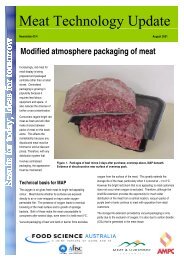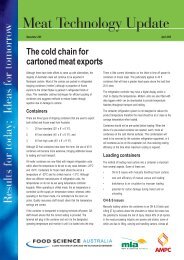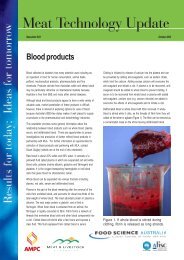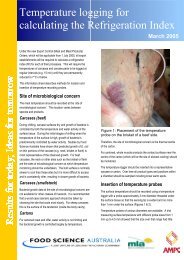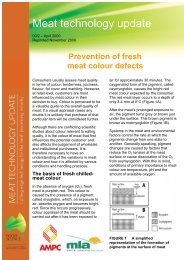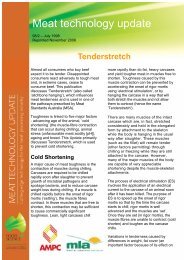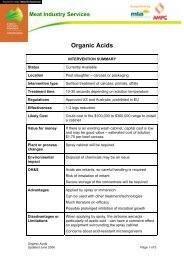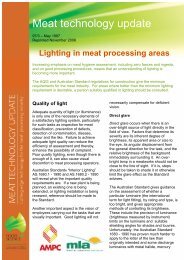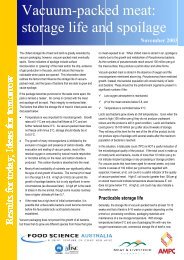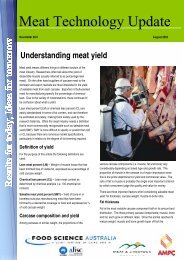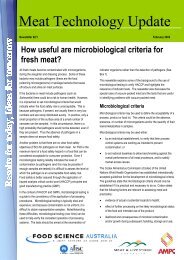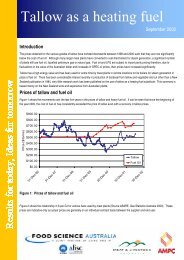Short-term Preservation of Hides and Skins - Red Meat Innovation
Short-term Preservation of Hides and Skins - Red Meat Innovation
Short-term Preservation of Hides and Skins - Red Meat Innovation
You also want an ePaper? Increase the reach of your titles
YUMPU automatically turns print PDFs into web optimized ePapers that Google loves.
<strong>Meat</strong> technology update<br />
98/3 – June 1998<br />
Reprinted November 2006<br />
<strong>Short</strong>-<strong>term</strong> <strong>Preservation</strong><br />
<strong>of</strong> <strong>Hides</strong> <strong>and</strong> <strong>Skins</strong><br />
<strong>Hides</strong> <strong>and</strong> skins, like meat, readily<br />
deteriorate. This is <strong>of</strong>ten overlooked.<br />
<strong>Short</strong>-<strong>term</strong> preservation methods are<br />
used to prevent deterioration <strong>of</strong> hides<br />
<strong>and</strong> skins before they are tanned, partprocessed<br />
or cured.<br />
This Update has been prepared by Udo<br />
Adminis <strong>and</strong> Catherine A. Money,<br />
CSIRO Leather Research Centre,<br />
Private Bag 10, Clayton South MDC,<br />
Vic., 3169.<br />
About 50% <strong>of</strong> Australian hides <strong>and</strong> skins<br />
are not salted before tanning, <strong>and</strong><br />
various methods have been developed to<br />
facilitate this green processing. Chemical<br />
methods <strong>and</strong> chilling are used to<br />
preserve hides <strong>and</strong> skins during<br />
transportation <strong>and</strong> storage. However,<br />
short-<strong>term</strong> preservation should be more<br />
widely used because green processing,<br />
which eliminates the cost <strong>of</strong> salting <strong>and</strong><br />
the environmental problems associated<br />
with the salt, is only worthwhile if there is<br />
no deterioration in the raw material.<br />
<strong>Short</strong>-<strong>term</strong> preservation is also<br />
necessary if there are delays before<br />
curing, drying or other processing, such<br />
as fellmongering.<br />
The development <strong>of</strong> regional brine-curing<br />
plants, wet-blue plants <strong>and</strong> woolskin<br />
tanneries has resulted in large numbers<br />
<strong>of</strong> hides being transported prior to<br />
processing, whereas in the past, hides<br />
were <strong>of</strong>ten immediately salted at their<br />
source. Many green hides are being held<br />
for several hours at temperatures above<br />
20°C <strong>and</strong> degradation is causing damage<br />
which is sometimes only apparent in the<br />
finished products. The grain layer <strong>of</strong> a<br />
hide is very susceptible to damage.<br />
As soon as the skin is removed from the<br />
animal it is susceptible to autolysis (self<br />
digestion) <strong>and</strong> bacterial degradation, <strong>and</strong><br />
the rate <strong>of</strong> degradation increases with<br />
temperature. Therefore, it is best to<br />
preserve the skins at their source. If there<br />
is a delay before treatment, the<br />
recommended methods will be less<br />
effective than expected.<br />
• In summer, the risk <strong>of</strong> hide damage is<br />
high. In sunny or hot weather the risk is<br />
very high.<br />
• Deterioration cannot be reversed by<br />
later chilling, preservation or<br />
processing. Even light damage to hides<br />
downgrades the resultant leather.<br />
• Best practice is to cool hides to 20°C<br />
within one minute <strong>of</strong> slaughter. If water<br />
is recycled, a biocide is required to<br />
prevent bacterial deterioration.<br />
• Chemical treatments within an hour <strong>of</strong><br />
slaughter can protect hides.
Comparison between Chemical<br />
<strong>and</strong> Chilling Methods<br />
Chemical methods are being used for up to<br />
10 days’ preservation at 25°C. They are<br />
mainly used for one to three days’<br />
preservation under mild climatic conditions.<br />
The main advantages <strong>of</strong> chemical<br />
methods are:<br />
1. The continuing protection given during<br />
transportation <strong>and</strong> delays.<br />
2. The ease <strong>of</strong> application, especially in<br />
tanning drums or converted concrete<br />
mixers.<br />
3. Treatments using either sodium chlorite<br />
or calcium hypochlorite alone do not<br />
affect by-products or effluent.<br />
The disadvantages <strong>of</strong> chemical methods<br />
are:<br />
1. They are not recommended when<br />
ambient temperatures are continuously<br />
above 30°C.<br />
2. All the chemicals need to be h<strong>and</strong>led<br />
with care, although some are more<br />
hazardous than others.<br />
3. Some <strong>of</strong> the chemicals cannot be used<br />
in particular circumstances owing to<br />
effluent restrictions or contamination <strong>of</strong><br />
by-products.<br />
4. Loosening <strong>of</strong> hair or wool can occur<br />
within two days at 25°C. This loosening<br />
is associated with the autolytic lysosomal<br />
enzymes present in skin <strong>and</strong> does not<br />
affect leather quality. However, because<br />
<strong>of</strong> the loosening:<br />
(a) most chemical methods are only<br />
suitable for the preservation <strong>of</strong><br />
woolskins <strong>and</strong> hair hides for 24 hours at<br />
no more than 25°C (there is less<br />
loosening with zinc chloride than with<br />
the other chemical treatments).<br />
(b) if hides are held for more than one day<br />
prior to salting or brine curing, the<br />
lysosomal hair-loosening can be<br />
mistaken for bacterial “hair-slip” in the<br />
salted hides.<br />
Chilling is used in various ways for holding<br />
hides <strong>and</strong> skins for up to three weeks.<br />
The main advantages <strong>of</strong> chilling are:<br />
1. <strong>Hides</strong> can be quickly chilled by water or<br />
ice as they come from the kill floor.<br />
2. No pollution.<br />
3. No contamination <strong>of</strong> by-products.<br />
4. Suitable for all hides <strong>and</strong> skins.<br />
5. No hair-loosening. Chilling is therefore<br />
suitable for woolskins <strong>and</strong> hides which<br />
will subsequently be cured or tanned<br />
with the wool or hair on.<br />
The main disadvantages <strong>of</strong> chilling are:<br />
1. <strong>Hides</strong> <strong>and</strong> skins are good insulators <strong>and</strong><br />
retain the body heat, so they should be<br />
chilled individually, immediately after<br />
removal.<br />
2. If low temperatures are not maintained<br />
during transport <strong>and</strong> storage, damage<br />
can occur.<br />
3. The temperature <strong>of</strong> chilled hides needs<br />
to be raised before unhairing.<br />
Chilling Methods<br />
The temperature to which hides <strong>and</strong> skins<br />
should be chilled depends on the required<br />
time <strong>of</strong> preservation. Table 1 gives the<br />
maximum storage period at various<br />
temperatures when chilling occurs<br />
immediately after removal. If there is a delay<br />
before chilling, the storage time at a<br />
particular temperature is reduced, e.g. there<br />
will be deterioration within one day if hides<br />
are left at body temperature for several hours<br />
before chilling to 20°C.<br />
Table 1 : Chilling <strong>of</strong> <strong>Hides</strong> <strong>and</strong> <strong>Skins</strong><br />
Storage Hide Temperature<br />
Maximum Storage<br />
Period<br />
20°C 1 day<br />
15°C 2 days<br />
10°C 5 days<br />
5°C 2 weeks<br />
0°C 3 weeks<br />
Various chilling methods can be used<br />
provided all areas <strong>of</strong> all hides <strong>and</strong> skins<br />
2
quickly reach the required temperature:<br />
• Crushed ice added to collection bins or<br />
drummed with hides, <strong>of</strong>ten in mixers.<br />
This is cost effective <strong>and</strong> the most<br />
commonly used method in Australia.<br />
Ice machines are bought or leased, or<br />
bulk loads <strong>of</strong> ice stored in chillers until<br />
required.<br />
• Fluming, spraying or bath washing with<br />
chilled water.<br />
• Application <strong>of</strong> dry ice particles (carbon<br />
dioxide snow - expensive).<br />
• Placing in a freezer.<br />
• Hanging hides on hooks on a conveyor<br />
in a chiller which can be mobile. In one<br />
chilling plant hides are hung on hooks<br />
on a continuous chain which firstly<br />
takes them through a high pressure<br />
washer, then through a chiller which<br />
chills them to 5°C in 48 minutes while<br />
they drain. They are then conveyed out<br />
<strong>of</strong> the chiller where, after trimming, they<br />
are automatically removed from the<br />
hooks into a crate for storage in the<br />
chiller.<br />
The flesh side <strong>of</strong> skins can partially dry out<br />
during chilling <strong>and</strong>, if these skins are<br />
subsequently salted, salt penetration<br />
problems occur. Moistening the skins before<br />
salting will allow rapid penetration <strong>of</strong> salt.<br />
If chilling facilities are not available but there<br />
are drying sheds on site, hanging sheepskins<br />
as for drying will lower their temperature. The<br />
skins can be further processed before they<br />
are dry but there must be compensation for<br />
the loss in moisture. This system is not<br />
recommended prior to salting.<br />
Chemical Methods<br />
The recommended methods are based on<br />
the use <strong>of</strong> either sodium chlorite, calcium<br />
hypochlorite, dithiocarbamates, zinc chloride<br />
or benzalkonium chloride (BAC). Sodium<br />
hypochlorite is not effective because it is not<br />
sufficiently stable. Sodium chlorite <strong>and</strong><br />
dithiocarbamates are the most widely used<br />
chemical short-<strong>term</strong> preservatives for hides.<br />
Higher levels <strong>of</strong> chemicals are needed in<br />
summer <strong>and</strong> for dung-covered hides than for<br />
clean winter hides.<br />
Safety precautions must be taken with the<br />
chemicals.<br />
Treatments for hides, calf, goat <strong>and</strong><br />
kangaroo skins<br />
Dimethyl dithiocarbamate (DTC) drum<br />
processes can be used for preservation for<br />
up to three weeks. In addition to the DTC,<br />
boric acid <strong>and</strong> BAC are required for the<br />
longer storage times.<br />
Each chemical supplier has individual<br />
recommendations <strong>and</strong> should be contacted<br />
for details.<br />
Imprapell (30% sodium chlorite), or calcium<br />
hypochlorite, zinc chloride or benzalkonium<br />
chloride in drum or soak treatments are<br />
recommended methods developed by<br />
CSIRO Leather Research Centre.<br />
Sodium chlorite has been used in Australia<br />
for 30 years, usually with no other additive.<br />
In Brazil it is preferred to chilling, <strong>and</strong> rotating<br />
drums attached to trucks are used to treat up<br />
to 1000 hides with Imprapell during transport.<br />
Drum methods are mainly used, <strong>of</strong>ten in<br />
mixers, but soak <strong>and</strong> spray methods are<br />
possible. Occasionally preservation has not<br />
been adequate <strong>and</strong> there has been some<br />
damage to the resultant leather. Although the<br />
reason for this has not always been<br />
identified, usually there has been a delay<br />
before treatment, the temperature has been<br />
too high, or insufficient chemical has been<br />
added.<br />
These short-<strong>term</strong> preservatives are mainly<br />
used to hold hides for one to three days <strong>and</strong><br />
it is not necessary to add a fungicide. For<br />
three to six days’ storage at 25°C, fungicides<br />
should be included to control mould growth.<br />
Owing to lysosomal hair-loosening (see<br />
disadvantages <strong>of</strong> chemical methods),<br />
chemical treatments are mainly used for<br />
hides being held prior to green processing,<br />
although the chemical methods can be used<br />
for up to one day’s preservation before<br />
salting.<br />
The choice <strong>of</strong> biocide used prior to salting<br />
will depend on several factors, including the<br />
possible effect on the effluent <strong>and</strong> the<br />
biocide used in brine curing. If a reducing<br />
agent such as dimethyl dithiocarbamate is<br />
3
added to the brine, benzalkonium<br />
chloride (BAC) or dimethyl<br />
dithiocarbamate could be used for<br />
short-<strong>term</strong> preservation. If the brine<br />
additive is sodium fluoride, then<br />
sodium chlorite could also be used as<br />
the biocide.<br />
Treatments for sheep <strong>and</strong><br />
lambskins<br />
Soak treatments: 20L/skin.<br />
For holding one day: benzalkonium<br />
chloride, zinc chloride, or Imprapell.<br />
For holding, more than one day: zinc<br />
chloride.<br />
General<br />
Some points to note are:<br />
• Chemical methods are not<br />
recommended for sheep <strong>and</strong><br />
lamb skins which are to be<br />
subsequently salted.<br />
• The choice <strong>of</strong> method will<br />
depend on particular conditions<br />
<strong>and</strong> requirements, including the<br />
subsequent fate <strong>of</strong> the hides or<br />
skins.<br />
• For all systems, bacterial growth<br />
must be controlled <strong>and</strong> this can<br />
be monitored with Dip Slides.<br />
• Temperature loggers are useful<br />
for monitoring the temperature<br />
pr<strong>of</strong>ile <strong>of</strong> hides during storage<br />
<strong>and</strong> transport. Suitable<br />
immersible loggers are available.<br />
• Provided it is done as each hide<br />
comes from the kill floor to avoid<br />
delay, hides can be fleshed<br />
before short-<strong>term</strong> preservation to<br />
improve tallow quality <strong>and</strong> to<br />
reduce weight <strong>and</strong> temperature.<br />
• For hides <strong>and</strong> skins which are to<br />
be salted after short-<strong>term</strong><br />
preservation, chemical<br />
treatments are only suitable for<br />
overnight storage, whereas<br />
chilling is recommended for<br />
longer periods.<br />
• It must be remembered that if<br />
hides or skins are wet by icing or<br />
chemical treatments prior to<br />
brining or salting, more salt is<br />
required for curing because all<br />
the moisture must be saturated<br />
with salt (see <strong>Meat</strong> Technology<br />
Update Nos. 94/2 <strong>and</strong> 94/3<br />
‘Curing <strong>of</strong> <strong>Hides</strong> <strong>and</strong> <strong>Skins</strong>’).<br />
Therefore, owing to the amount<br />
<strong>of</strong> water held by the wool, if<br />
sheepskins are wet during short<strong>term</strong><br />
preservation, either by a<br />
chilling method or a chemical<br />
soak treatment, the water should<br />
be removed before salting. A<br />
chilling method which does not<br />
wet the skins is the preferred<br />
treatment <strong>of</strong> sheepskins to be<br />
subsequently salted.<br />
Supplementary material on the<br />
recommendations, properties <strong>of</strong> the<br />
chemicals, safety precautions <strong>and</strong><br />
effects on effluent <strong>and</strong> by-products is<br />
available in the Further Information<br />
Paper ‘<strong>Short</strong>-<strong>term</strong> <strong>Preservation</strong> <strong>of</strong><br />
<strong>Hides</strong> <strong>and</strong> <strong>Skins</strong>’.<br />
Contact us for additional information<br />
<strong>Meat</strong> Industry Services is supported by the Australian <strong>Meat</strong> Processor Corporation (AMPC) <strong>and</strong> <strong>Meat</strong> & Livestock Australia (MLA).<br />
Brisbane: Sydney: Adelaide:<br />
Food Science Australia Bill Spooncer Chris Sentance<br />
PO Box 3312 PO Box 181 PO Box 178<br />
Tingalpa DC QLD 4173 KURMOND NSW 2757 FLAGSTAFF HILL SA 5159<br />
Ian Eustace Neil McPhail Alison Small<br />
T +61 7 3214 2117 T +61 7 3214 211 T +61 7 3214 2109 T +61 2 4567 7952 T +61 8 370 7466<br />
F +61 7 3214 2103 F +61 7 3214 2103 F +61 7 3214 2103 F +61 2 4567 8952 F +61 8 8370 7566<br />
M 0414 336 724 M 0414 336 907 M 0409 819 998 M 0414 648 387 M 0419 944 022



